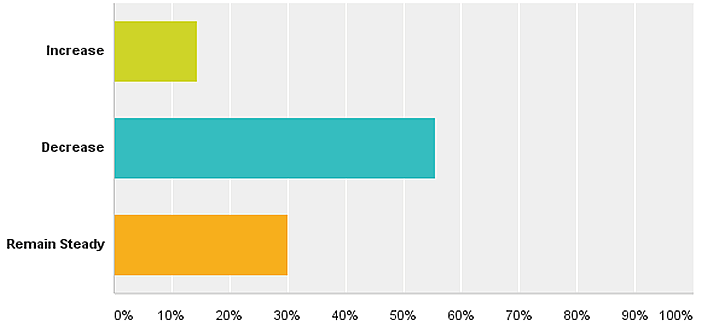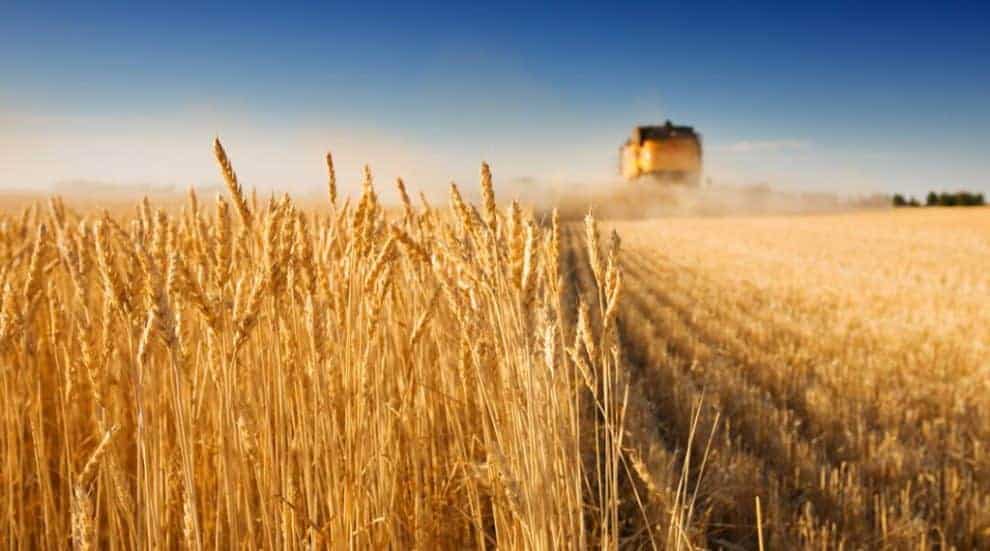According to February LANDTHINK Pulse results, 55.60% of respondents believe that if commodity prices continue to decline, land real estate prices will DECREASE. In light of falling commodity prices, land prices, especially across America’s Corn Belt, have been modestly declining. Low prices for large crops like corn and soybeans have been the primary factor in the overall decline of both dry and irrigated cropland. Although, according to most recent surveys, irrigated cropland has not been declining as quickly as dry cropland. Dryland crops such as millet, sorghum, and wheat have a more variable agricultural output and revenue. In most states, grazing, haying and pastureland are the only categories where prices have slightly increased, due to high cattle prices and increasing cash rental rates.
Last month, the February Pulse asked: What will happen to land real estate prices if commodity prices continue to decline?
There is no uniformity to rising and falling land prices- they vary in counties across every state. After multiple years of increasing farmland values, the market peaked in 2013. Price per acre of high quality, productive agricultural land soared to record levels, due to increased demand for corn and soybeans, bad weather, high commodity prices and low interest rates. Our informal online survey revealed that 55.60% of those responding believe that if commodity prices continue to decline, land real estate prices will DECREASE. This was followed by 30% of our audience who thought land prices would REMAIN STEADY if commodity prices keep dropping. A mere 14.40% thought land prices would INCREASE. Land prices leveled out and have already begun declining, but most farmers understand it’s a cycle and are well-prepared for what’s to come. Farmers will likely tighten-up their belt and spend less money on farm equipment, opting to lease instead of buy. Since existing farmers are the primary buyers of farmland, they will be more conservative and cautious with additional purchases. Analysts, economists and lenders predict that most farmers will continue to see profits, but nowhere near the levels of a few years before.
Here are the final results:

- 55.60% said land prices would DECREASE in wake of declining commodity prices
- 30% said land prices would REMAIN STEADY in wake of declining commodity prices
- 14.40% said land prices would INCREASE in wake of declining commodity prices
Thank you to everyone who participated and shared the Pulse with friends and connections in the land industry.
LANDTHINK is seeking a sponsor for the April LANDTHINK Pulse and months thereafter. The spring and summer buying season has arrived! There’s no better time for land industry businesses and professionals to sponsor the Pulse question! Pulse sponsorships are offered on a first come first serve basis and are subject to certain limitations. If your business would be interested in sponsoring next month’s April Pulse question, please contact us soon.
Do you have a suggestion for next month’s Pulse question? Submit your question here and we might choose yours!
In your opinion, which factor has the largest impact on the overall health of the rural land market? Tell us what you think! Click here to answer the March Pulse question!
This content may not be used or reproduced in any manner whatsoever, in part or in whole, without written permission of LANDTHINK. Use of this content without permission is a violation of federal copyright law. The articles, posts, comments, opinions and information provided by LANDTHINK are for informational and research purposes only and DOES NOT substitute or coincide with the advice of an attorney, accountant, real estate broker or any other licensed real estate professional. LANDTHINK strongly advises visitors and readers to seek their own professional guidance and advice related to buying, investing in or selling real estate.










Add Comment